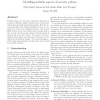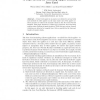ICCHP
2004
Springer
14 years 6 months ago
2004
Springer
David tries not to use unfamiliar trains and buses, he doesn’t travel to places he doesn’t know, and he doesn’t travel in unusual environments without a companion. David is v...
ICCHP
2004
Springer
14 years 6 months ago
2004
Springer
In this paper, we introduce the concept of ”user policies”. The objective of policies is to specify user preferences in terms of presentation and interaction with information. ...
ICCHP
2004
Springer
14 years 6 months ago
2004
Springer
In this paper we introduce the characteristics of the educational platform that is being developed within the SYNENNOESE project. The platform integrates avatar and animation techn...
ICCHP
2004
Springer
14 years 6 months ago
2004
Springer
This paper gives a brief overview about the partially EU funded project IST-2000-25420 FASTY in the IST program. The objective of FASTY was the creation of a system for increasing ...
ICCHP
2004
Springer
14 years 6 months ago
2004
Springer
: Multimedia and Hypermedia technologies can be successfully used in education and rehabilitation for cognitively disabled persons. In particular, storytelling has always proved su...
ICCHP
2004
Springer
14 years 6 months ago
2004
Springer
ICCHP
2004
Springer
14 years 6 months ago
2004
Springer
Abstract. This paper presents the eAccessibilityEngine tool, which employs adaptation techniques to automatically render web pages accessible by users with different types of disab...
CASSIS
2004
Springer
14 years 6 months ago
2004
Springer
Abstract. This short paper introduces the issues and challenges of next generation Java-based smart card platforms. Betting on a continuous evolution toward open computing devices,...
CASSIS
2004
Springer
14 years 6 months ago
2004
Springer
Security policies are rules that constrain the behaviour of a system. Different, largely unrelated sets of rules typically govern the physical and logical worlds. However, increa...
CASSIS
2004
Springer
14 years 6 months ago
2004
Springer
A Java Card applet is, in general, not allowed to access fields and methods of other applets on the same smart card. This applet isolation property is enforced by dynamic checks i...


